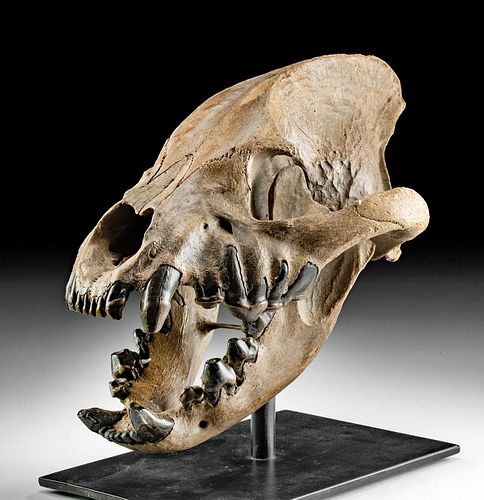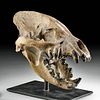Impressive & Rare Fossilized Cave Hyena Skull - Choice!
Lot 166a
About Seller
Artemis Gallery
686 S Taylor Ave, Ste 106
Louisville, CO 80027
United States
Selling antiquities, ancient and ethnographic art online since 1993, Artemis Gallery specializes in Classical Antiquities (Egyptian, Greek, Roman, Near Eastern), Asian, Pre-Columbian, African / Tribal / Oceanographic art. Our extensive inventory includes pottery, stone, metal, wood, glass and textil...Read more
Categories
Estimate:
$32,000 - $48,000
Absentee vs Live bid
Two ways to bid:
- Leave a max absentee bid and the platform will bid on your behalf up to your maximum bid during the live auction.
- Bid live during the auction and your bids will be submitted real-time to the auctioneer.
Bid Increments
| Price | Bid Increment |
|---|---|
| $0 | $25 |
| $300 | $50 |
| $1,000 | $100 |
| $2,000 | $250 |
| $5,000 | $500 |
| $10,000 | $1,000 |
| $20,000 | $2,500 |
| $50,000 | $5,000 |
| $100,000 | $10,000 |
| $200,000 | $20,000 |
About Auction
By Artemis Gallery
Oct 7, 2021
Set Reminder
2021-10-07 10:00:00
2021-10-07 10:00:00
America/New_York
Bidsquare
Bidsquare : Exceptional Antiquities Ethnographic Fine Art
https://www.bidsquare.com/auctions/artemis-gallery/exceptional-antiquities-ethnographic-fine-art-7537
Museum-worthy examples of Egyptian, Greek, Roman, Etruscan, Near Eastern, Far East / Asian, Pre-Columbian, African / Tribal, Oceanic, Native American, Spanish Colonial, Fossils, Ancient Jewelry, Fine / Visual Arts, so much more! Artemis Gallery info@artemisgallery.com
Museum-worthy examples of Egyptian, Greek, Roman, Etruscan, Near Eastern, Far East / Asian, Pre-Columbian, African / Tribal, Oceanic, Native American, Spanish Colonial, Fossils, Ancient Jewelry, Fine / Visual Arts, so much more! Artemis Gallery info@artemisgallery.com
- Lot Description
Central Asia, Eastern Kazakhstan, Altai Mountains, Pleistocene epoch, ca. 2 million to 10,000 years ago. It is remarkable to see such a fascinating fossilized skull from the extinct cave hyena, also known as the Ice Age spotted hyena (Crocuta crocuta spelaea), because so few of their remains survive intact! This is the most complete example for sale that we have seen and totally original material! Most museums have fragmented pieces or reconstructions of these animals. This skull has been shockingly preserved to near perfection - due to the location in which it was found - protected within a cave from the elements. It is displayed to show off the teeth within the incredibly powerful jaws - these animals ate everything from reindeer and horses to woolly rhinos, accumulating their bones and horns in their cave dens. In Siberia, there is evidence they also ate cave bears! The fossilization process has left the bones a rich brown umber color, and the teeth are a pretty black and mottled brown. This is a very rare specimen due to its perfect condition and desirability for collectors and institutions! Size: 13.5" L x 8" W (34.3 cm x 20.3 cm); 10" H (25.4 cm) on included custom stand.
Although their DNA is not significantly different from modern African hyenas, cave hyenas were considerably larger than their modern ancestor. Note the heavy nature of the skull, reinforced for the hyena's rough life of hunting animals larger than itself and contending with neighboring predators - notably wolves. These cave hyenas were subspecies the spotted hyena, which is the only modern living member of the Crocuta family. Cave hyenas, also known as the Ice Age Spotted Hyena, were encountered by prehistoric humans and depicted in cave art, including the Chauvet Cave and Lascaux. Archaeologists also found an atlatl weight carved of mammoth ivory in the form of a crouched hyena, perhaps meant to depict the animal stalking its prey, in the La Madeleine rock shelter, dating ca. 12000-17000 BP. This species once ranged from Iberian Peninsula to Russia. This hyena was a highly specialized animal, weighing approximately 230 pounds (104 kg), hunted in packs, and ate wild horses, steppe bison, and wooly rhinoceros. Like many prehistoric animals, the cause of extinction is not fully understood, but likely due to climate change, and an inability to compete with other predators. Of all the skulls, we think this is one of the most special and well-preserved examples of a pre-historic ice age predator. Because they often scavenged, including their own deceased kin, the bones are often broken and scattered, never truly complete or preserved, which is why we stress how rare this skull is!
This piece has been searched against the Art Loss Register database and has been cleared. The Art Loss Register maintains the world’s largest database of stolen art, collectibles, and antiques.
Provenance: private Rome, Georgia, USA collection
All items legal to buy/sell under U.S. Statute covering cultural patrimony Code 2600, CHAPTER 14, and are guaranteed to be as described or your money back.
A Certificate of Authenticity will accompany all winning bids.
We ship worldwide and handle all shipping in-house for your convenience.
#164973Professional restoration to small depression on top left side of skull that is now concealed and nearly invisible. Stable fissures from fossilization process. Teeth are intact. Lower jaw attached to a wire to display on stand. Great coloration and exceedingly rare.Condition
- Shipping Info
-
All shipping is handled in-house for your convenience. Your invoice from Artemis Gallery will include shipping calculation instructions. If in doubt, please inquire BEFORE bidding for estimated shipping costs for individual items.
-
- Buyer's Premium



 EUR
EUR CAD
CAD AUD
AUD GBP
GBP MXN
MXN HKD
HKD CNY
CNY MYR
MYR SEK
SEK SGD
SGD CHF
CHF THB
THB














